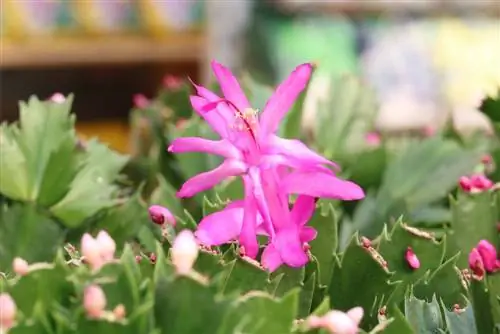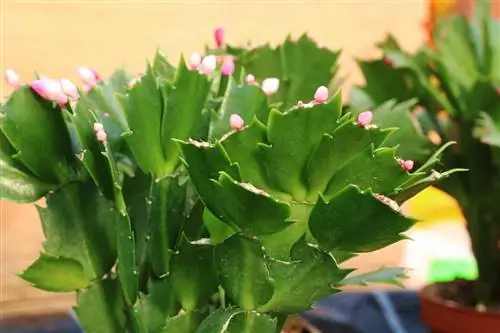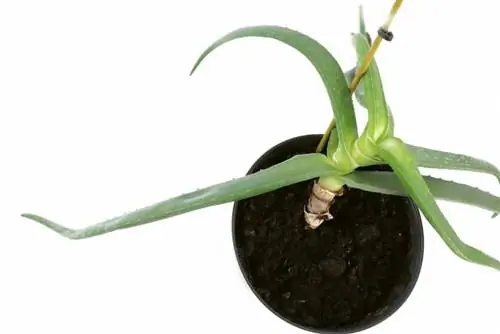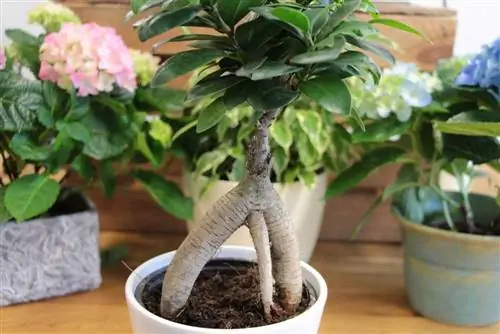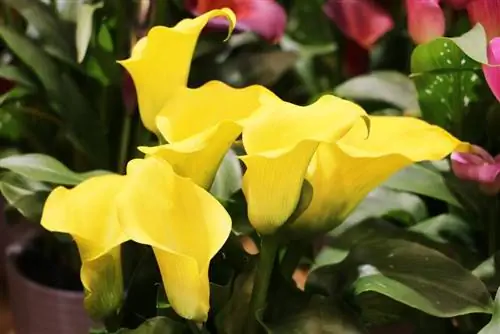- Author admin [email protected].
- Public 2023-12-17 03:39.
- Last modified 2025-01-24 12:45.
The Christmas cactus has the botanical name Schlumbergera and produces lush inflorescences during the Christmas season, which is why it got its name. The plant originally comes from the tropical rainforests of Brazil, which is why it is not hardy and can only be kept as a houseplant. Since the plant is constantly growing, periodic repotting is advisable. In addition, it can be easily propagated through its offshoots.
Repotting
In its ancestral homeland, the Christmas cactus grows in the forks of large trees and forms limbs that hang down over time. If the care and location conditions in your home are right, the limbed cactus can reach impressive dimensions, both in height and width. That's why the flower pots quickly become too small and there's no room for the roots. In this case, it is time to repot the plant and place it in a larger container. Repotting should always be done after the flowering period; shortly before flowering and during the flowering phase, the cactus should be left alone and not stressed unnecessarily. Since Christmas cacti only form a relatively small root ball, the new planters don't have to be too big so that they have enough space.
- The optimal time is in March
- If growth is lush, proceed annually
- Carefully lift the plant out of the old flower pot
- Gently shake off the old substrate and wipe it off carefully
- Choose a slightly larger planter
- Clean this and fill it with fresh soil
- Insert the limbed cactus in the middle
- Fill additional substrate and press lightly
- Afterwards, water the root ball well
- Do not carry out if flower buds are already visible
Tip:
Due to the drooping growth habit, hanging baskets are also suitable as planters for the cactus. Especially during the flowering period, the living spaces are beautifully enhanced with these decorative plants.
Pot & plant substrate
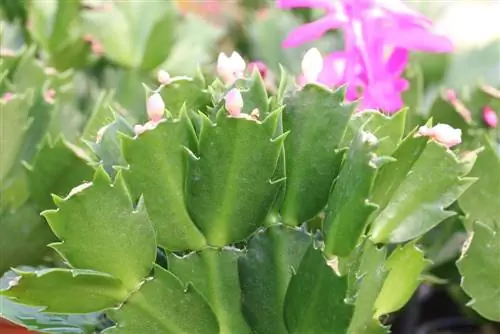
So that the perennial cactus can develop its flowers every winter, it depends on a certain nutrient content in its planter. This should neither be too low nor too high. If the plant is repotted, it is a good idea to provide it with fresh planting substrate. In this way, the nutrients in the flower pot are retained evenly. The planter must have a sufficiently large drainage hole so that the irrigation water can drain away promptly. Otherwise the container will become waterlogged, which the plant will not tolerate well. In this context, good soil permeability is also important so that the root system receives optimal growth conditions. In the summer months, the plant can spend a few weeks outdoors, but due to the lack of winter hardiness, the plant has to move back indoors when temperatures drop in autumn.
- Choose the diameter of the new pot about 1-2 cm larger
- Special cactus soil is perfectly tailored to your needs
- Alternatively, potting soil from specialist retailers is also suitable
- Loosen these up with sand and small gravel
- In the ratio of four parts substrate to one part sand and gravel
- Substrate should not be too nutrient-rich
- The ideal pH value is between 5.5 and 6.0
- Create drainage in the bottom of the pot
- Put out pottery shards via the drain hole
Propagate with cuttings
Propagation through seeds is definitely possible with the Christmas cactus, but it is much easier to propagate with cuttings. The plant forms densely branched shoots that consist of individual limbs, which is why the name limb cactus has become common. For propagation, the end pieces are removed from the plant, which are located at the end of each shoot. These structures resemble leaves and are known in technical language as phylloccladia. To do this, the cuttings are carefully removed from the mother plant by hand so as not to injure the cactus. If several offshoots are cultivated in one planter at the same time, the growth will be much denser. Cutting off the limbs is not recommended as this process only creates unnecessary stress and a risk of infection for the plant.
- Propagation is best achieved through offshoots
- The best time for reproduction is in early summer
- Special potting soil is ideal
- Separate cuttings with 2-3 phyllocladia
- Only use shoot pieces from the end
- Plant the cutting at a depth of about 3 cm
- Water the substrate well and keep it evenly moist
- However, avoid waterlogging
- Do not fertilize in the beginning
- Bright and warm location conditions are optimal
- Observe temperature values between 22°-28° Celsius
- Avoid direct sunlight and midday heat
- Rooting takes place after approx. 4 weeks
Tip:
The largest and most mature phyllocladia possible should be used for propagation. The degree of ripeness can be recognized by the significantly darker green color, as the new shoots are more light green.
Propagation with seeds
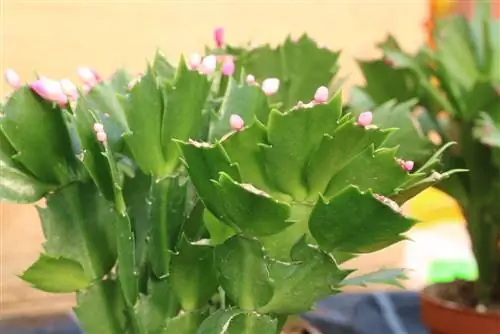
The Christmas cacti not only produce distinctive flowers, but under the right conditions they also produce fruits with seeds. These fruits burst open when ripe and contain many tiny seeds. However, sowing seeds is only possible the following spring. In addition, it takes a while for the seeds to germinate and usually not all of the seeds sprout. Therefore, the chances of success with this propagation method are significantly lower than with propagation with cuttings.
- Shake the seeds out of the fruit
- Remove pulp completely
- Allow seeds to dry out thoroughly
- Store in a dry place until sowing in March or April
- Fill small seed trays with cactus soil
- Alternatively, you can also use loose potting soil
- Sow seeds as thinly as possible
- Cover the sowing with a thin layer of soil
- Keep plant substrate constantly moist
- But don't water too much, be sure to avoid waterlogging
Tip:
A flower sprayer is best suited to moisten the substrate so that the seeds are not washed out of the soil with the irrigation water.
Pricking
After emergence, the young plants must be pricked out, otherwise they will not have enough space for he althy growth in the rather small cultivation container. This process occurs when the young Christmas cacti have reached a height of around two to three centimeters. In a sufficiently large planter, several specimens can be grown close together so that they then merge to form a densely growing cactus. However, the plants should not be squeezed too tightly together.
- Pull out young plants that are too close together
- Transplant into larger containers with cactus soil
- Always prick very carefully
- Avoid injuries at all costs
- Now care for individual plants like adult Christmas cacti

